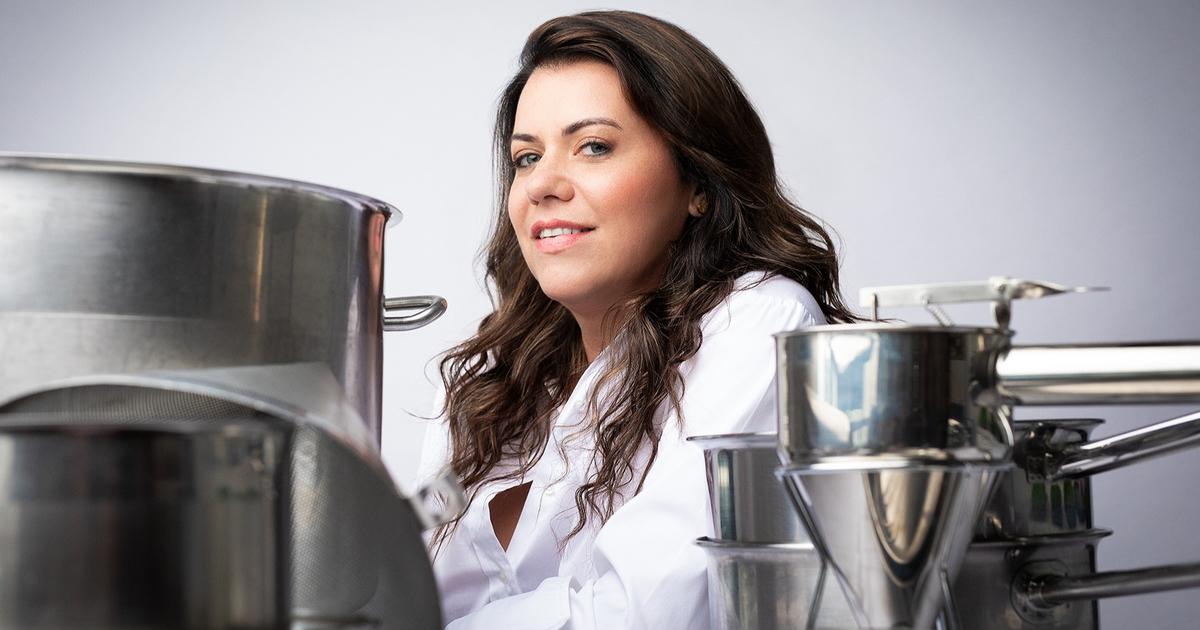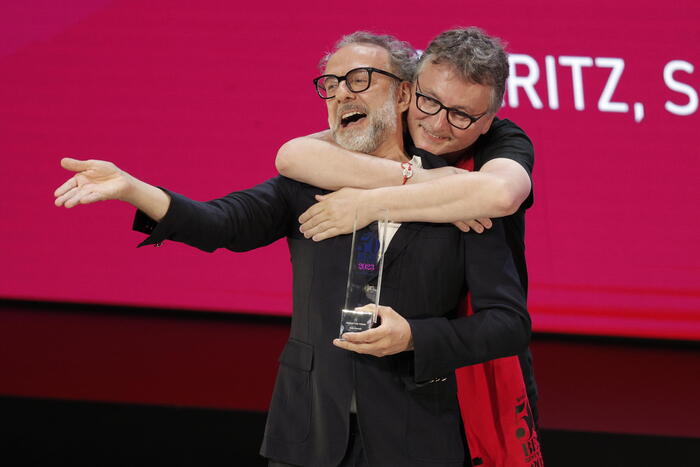The road that leads from Pujol, fifth on the list of The World's 50 Best Restaurants, to the ninth establishment in that classification, Quintonil, can be covered in seven minutes on foot.
The minuscule adventure, possible only in Mexico City, is unexpectedly shot through with grandiose airs.
From tree-lined Alfred Tennyson street, where Pujol is, you then have to go through Aristoteles, Galileo, Temístocle, until you finally reach Isaac Newton, the street of French-style houses where Quintonil is located.
It's as if the sages of other times symbolically amplified the prominence of these restaurants, as if foreshadowing their potential to make history.
Thus, the gastronomic memory woven by Pujol made of the daring of some al pastor tacos, but with
sea bass
, some
elotitos
—ear of tender corn— with Chicatana ant mayonnaise, or
mother mole
, a perfect mix of chili peppers and chocolate , is barely 500 meters away from Quintonil's own experiments, which with its string cheese soup with
casacán —a particularly meaty pork rind— or with its
huauzontle
croquettes
—plant native to the country— has taken diners to the bowels of Mexican homes.
This territorial proximity, which is accentuated when one sees its closeness in the international lists of the best in the world, is just the evidence of the multiple threads that closely connect the two restaurants and their chefs.
Baby corn with Chicatana ant mayonnaise, from Pujol, in an image provided by the restaurant.
Quintonil was born from a love that was cooked in the very bowels of Pujol.
Jorge Vallejo and Alejandra Flores, creators of the restaurant, met and fell in love, both working under the leadership of Enrique Olvera.
Vallejo was kitchen manager, while she handled service issues.
Like so many other prominent chefs in the city, passing through Olvera's impeccable and precisely coordinated kitchens became a fundamental stepping stone for them to later undertake their own explorations of Mexican food.
“Pujol was a great school, it was the place where I met the love of my life, there is great affection and a great fraternity with the cooks,” says Flores.
Chef Vallejo confirms it: “Yes, we have created a community.
There is that mutual, fraternal, disinterested affection,
The gestation of a true fraternal and friendly generation of Mexican cooks that today shine and place Mexico City as one of the most visited cities in the world, did not seem to be, however, a deliberate intention of Enrique Olvera.
“I returned to Mexico in the late 1990s, just as restaurants were making the leap from
casual
dining to haute cuisine.
This coincidence helped us because there was a lot of interest from the younger generations to work with us.
Jorge Vallejo or Eduardo
Lalo
García, like many others, when they returned to Mexico after working abroad, they wanted to go through Pujol.
They came from that world of haute cuisine and could continue it here”, explains Olvera.
What the creator of Pujol does acknowledge that he did with full intention is to have given chefs space to grow their own talent.
"Respecting his imprint was always something important to me, all of Pujol's chefs give the restaurant their personality, it is a very special relationship because they leave us very good years of their lives, and then Pujol serves as a base for them to be able to start their own business."
Jorge Vallejo and Alejandra Flores, from the Mexican Quintonil, in an image provided by the restaurant.
Actually, no one was surprised that Enrique Olvera created these veritable circles of virtuous people around his kitchen.
He himself, since his beginnings, when he wanted to find a clear concept for Pujol and still served
foie gras
sandwiches to his diners, had opened up to listen to the knowledge of the elders.
To listen to the advice of Alicia Gironella, considered the grandmother of Mexican cuisine, to respect the journeys expressed in the gray hairs of Carmen
Titita
, knowledgeable about food from the El Bajío region, and to learn from Ricardo Muñoz Zurita, master of research Mexican gastronomy.
“He realizes that he could create that same dialogue in his restaurants, because he had also learned from others and wanted to teach himself,” explains Claudio Poblete, chef and founder of Culinaria Mexicana.
“What he forcefully trained them all in was the iron discipline of a high school restaurant.
With prodigious people in the kitchen like Jorge Vallejo, Eduardo García, Mario Espinoza, Alejandro Villagomez, all those chefs, more than disciples, are people who learned to work differently”.
Moorish crab in green sunflower seed pipián, Thai lime and basil, blue corn toast, from Quintonil, in an image provided by the restaurant.
Enrique Olvera confesses that if there is one thing he has pursued from his kitchen, it is that Mexico, with its wealth of flavors, is not defined by the style of a single chef.
“Something that I always liked about Mexico and that I have done very intentionally is that there is not a single line in your kitchen.
When in a country there is a chef who is very protagonist, the line of that chef is noticeable, I have tried not to encourage that.
When I talk to my friends, I like to see, for example, that Elena Reygadas, from Rosetta, has a very marked line of Mexican cuisine, but with her own history and that happens a lot with the other chefs”, explains Olvera, who continues to find in its tacos, those served at the Pujol bar, the surest way to unravel the ingenuity of its cuisine.
The experience of avocado and purple corn
This diversity of flavors and preparations that are lived in Mexico, this breadth of experiences created with the avocado, from Michoacán, with purple or blue corn or with Mexican vanilla, is confirmed by the foodies who come to the capital with the iron conviction of know both Pujol and Quintonil.
“Diners tend to insist on going to both restaurants, because they know that despite being in the same exclusive area of Polanco, basing their flavors on the best ingredients that define Mexico and on the intersections that combine their own history, they will be able to having radically different experiences, where one is an exquisite multisensory experience and the other is a tasty emotional journey through the ways in which we Mexicans conceive of food”, explains Mariana Camacho, Mexican food critic and journalist.
Since 2017 Pujol has had a taco bar, one of the restaurant's big bets.
This is the lobster, Brussels sprout, macadamia cottage cheese.
An image provided by the restaurant.
The main value of his kitchen, says chef Jorge Vallejo, is the honesty with which he has made his preparations.
"This honesty is worth more than any speech or post-tourism, it is worth more to be genuine, than to
lobby
," confesses the cook who with his roasted avocado with
escamoles
—ant eggs— and its sea bass with grasshoppers, evokes a recent anecdote to translate for readers what happens inside Quintonil: “This was told to me by a dear chef friend who recently ate at the restaurant.
And it is that, despite being dishes with a lot of technique, she felt that each time, that each bite of it, spoke to her of what my life had been like, of how I ate when I was little.
She moved me to have that ability to convey who I am through the dishes.
At the end of the day, that's what cooking is all about, creating a feeling.
The true success is lived with the diners feeling”.
This invisible closeness that is woven between chiles and
quelites
—edible leaves and herbs— between two of the most vibrant and best restaurants in the city is also a symptom of something compelling that is happening in the Mexican capital.
"For me, what is happening in Mexico is a dream come true," confesses Olvera.
“In the late 1990s, when I was studying in the United States, there was a very important movement with chefs like Thomas Keller, Alice Waters and Larry Forgione, who were proposing a new style for their American food.
When I returned to Mexico I thought, we have much more to offer, we have a broader pantry and a deeper and more diverse history.
In Mexico this should be able to happen.
I feel that in recent years this is already happening, we are living that revolution”.









